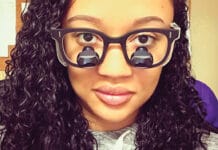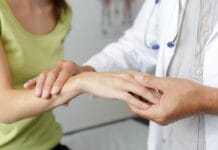Are you in need of CE credits? If so, check out our peer-reviewed, self-study CE courses here.
Test Your Historical Women in Dentistry Knowledge
1. What year did Irene Newman first perform the duties of a dental hygienist?
The same year Dr. Alfred Fones graduated dental school (1890), bacteria were linked to the cause of dental decay. At the time, dentists were trying several ideas to combat bacteria. One such idea was "Odontocure," where "a woman with an orange wooden stick, pumice, and a flannel rag patrolled the neighborhood cleaning teeth."1 However, dentists were so busy extracting teeth that many gave up trying to provide preventive treatment. Dr. Fones was not one who gave up!
Dr. Fones trained his cousin, who was his dental assistant, to provide preventive treatment. In 1907 Irene Newman (1875-1958) first performed the duties of what Dr. Alfred Fones called a dental hygienist. Much of the public scoffed at the idea of visiting the dentist regularly for check-ups and preventive care, but some did support it.
In 1913, Dr. Alfred Fones and Irene Newman began instructing the first class of dental hygienists. People came from as far as Japan to their carriage house basement clinic in Bridgeport, Connecticut, to learn this new profession. Dr. Fones helped E. Everett Cortright found the Junior College of Connecticut, which is now the University of Bridgeport.
"The state of Connecticut was so impressed they issued the world's first license for practicing dental hygiene to Irene Newman. The idea quickly caught on around America and the world. Due to the hygiene program in place in the city, Bridgeport had the lowest death rate of any large city in the world during the influenza pandemic of 1918."1
Dr. Fones and Irene Newman also implemented dental health programs in schools to teach children about oral hygiene at home, how to and the importance of it.
1. Lehman, E. (n.d.). Alfred Fones, Irene Newman, and the Dental Hygiene Revolution. Bridgeport Library: Bridgeport History Center. https://bportlibrary.org/hc/education/dr-alfred-fones/
2. Which of the following women helped form the American Academy of Periodontology?
Dr. Gillette Hayden (1880-1929) was the great-granddaughter of Horace Hayden, who was one of the founders of the first dental college in Baltimore, Maryland. In 1902, she was the third woman to graduate the Ohio Medical University's dental school.
In 1908, after traveling to Europe to introduce periodontal disease treatment protocols, Dr. Hayden returned to Columbus, Ohio, and devoted her dental practice exclusively to periodontics.
In 1914, along with Dr. Grace Rodgers Spalding, Dr. Gillette Hayden, helped form the American Academy of Periodontology (AAP). Dr. Hayden was the president of the AAP in 1916, was later elected a fellow, and continuously served on the executive council until her death in 1929.
Dr. Hayden also served as president of the Federation of American Women Dentists in 1923 and was elected secretary of the periodontia section of the International Dental Congress in 1925. She was a part of the equal rights movement and was involved in several organizations and groups.
Gillette Hayden. (2014, May 6). The Ohio State University. https://library.osu.edu/site/mhcb/2014/05/06/gillette-hayden/
3. In 1890, Dr. Ida Gray Nelson Rollins became the first African American woman to graduate with a dental degree.
Dr. Ida Gray Nelson Rollins (1867-1953) was born in Clarksville, Tennessee. Her mother passed away, and her father was estranged, so she was raised by her aunt, who could not read or write. The family moved to Cincinnati, Ohio, and while in high school, Dr. Ida Gray Nelson Rollins worked as a seamstress and in a dental office. It was this dental office owned by Drs. William and Jonathan Taft, where she found her love of dentistry.
Dr. Taft, who employed Dr. Ida Gray Nelson Rollins, was the dean of the Ohio College of Dentistry and then later the dean of the Dental College at the University of Michigan. He was a significant supporter of admitting women to dental school and mentored Dr. Ida Gray Nelson Rollins.
She enrolled at the University of Michigan in 1887. Three years later, she became the first African American woman to graduate with a Doctor of Dental Surgery in the U.S. After graduating in 1890, Dr. Ida Gray Nelson Rollins returned to Cincinnati, Ohio, and opened her dental practice.
Dr. Ida Gray Nelson Rollins married Spanish-American war veteran Sanford Nelson, and they moved to Chicago, Illinois, where she opened a practice that served men and women of all races. She was the first African American, man or woman, to practice dentistry in Chicago.
Her husband passed away, and she married William Rollins. Dr. Ida Gray Nelson Rollins retired from clinical practice in the mid-1930s. Sadly, her second husband passed away from injuries related to a car accident in 1944. Dr. Ida Gray Nelson Rollins passed away at age 86 in 1953. She is a tremendous example of not allowing a rough start to determine your success in life.
Agbor-Taylor, P. (2013, November 22). Ida Gray Nelson Rollins (1867-1953). Black Past. https://www.blackpast.org/african-american-history/rollins-ida-gray-nelson-1867-1953/
4. Who was the first dentist in the U.S. to specialize in pediatric dentistry?
Dr. Minnie Evangeline Jordan (1865-1952) was the first U.S. dentist to focus her practice on children and is considered a founder of pediatric dentistry. Dr. Fanny A. Rambarger limited her practice to women and children, but not strictly children, as Dr. Minnie Evangeline Jordan did.
Dr. Minnie Evangeline Jordan's career began in education as a teacher. During summers, she would work as a dental assistant, which led her to study dentistry at the University of California. She graduated in 1898 and opened a dental clinic at the Orphan's Home, where she developed a course called "Care of Children's teeth."
Dr. Jordan strongly believed that diet played a role in dental health and recognized the need for education and specific training in the treatment of pediatric dental patients. She was one of the first dentists who recognized "baby bottle decay." Dr. Jordan is quoted saying (1925), "Rid the country of the deadly candy shop and grocery store, get most of your living from the vegetable garden and the family cow, and apply the teaching of oral hygiene."
Dr. Minnie Evangeline Jordan was also one of the founders of the American Society of Dentistry for Children.
Timeline of Women in Dentistry. (n.d.). History of Dentistry. http://www.historyofdentistry.net/famous-dentists/timeline-of-women-in-dentistry
M. Evangeline Jordan. (n.d.). Sindecuse Museum. https://www.sindecusemuseum.org/m-evangeline-jordon
10 Pioneering Women in Dentistry. (2021, September 22). American Orthodontic Society. https://orthodontics.com/pioneering-women-in-dentistry/
5. Dr. Lucy Hobbs Taylor was the first American woman to earn a degree in dentistry in the U.S. She began her practice in 1861, prior to graduating from dental school in 1866.
Dr. Lucy Hobbs Taylor (1833-1910) began her career in 1849 as a schoolteacher. While teaching, she began the study of medicine. However, she was not allowed admittance to the Eclectic College of Medicine in Ohio because she was a woman, so she studied privately under one of the professors. This professor suggested a focus on dentistry. Yet again, she was refused admission because she was a woman, this time to the Ohio College of Dental Surgery, so she studied privately under the dental school's dean.
Without a bona fide degree in dentistry, Dr. Lucy Hobbs Taylor apprenticed herself as a practicing graduate of the school and opened her dental practice in 1861. In July 1865, she was elected as a member of the Iowa State Dental Society. In addition, Dr. Hobbs was sent as a delegate to the American Dental Association convention, all the while before being accepted or completing dental school.
It wasn't until November 1865 she was allowed admittance to the senior class of the Ohio College of Dental Surgery. She graduated in February 1866 as the first woman to earn a degree in dentistry in the U.S. From there, Dr. Lucy Hobbs Taylor practiced in Chicago and married James M. Taylor in 1867, who became a dentist at her instruction.
In 1867, Dr. Lucy Hobbs Taylor and Dr. James M. Taylor moved to Kansas and opened a large dental practice. She avidly supported the women's suffrage movement and practiced until her husband's passing in 1886.
Lucy Hobbs Taylor. (2022, September 29). Britannica. https://www.britannica.com/biography/Lucy-Hobbs-Taylor
6. Who wrote the textbook Clinical Practice of the Dental Hygienist, also known as the "Bible of Dental Hygiene?"
This was a freebie! If you are a dental hygienist and you got this one wrong, please reflect on your career path. All jokes aside, Dr. Esther M. Wilkins (1916-2016), the "Godmother of Dental Hygiene," was the author of the textbook we all grew to love through our studies in dental hygiene school.
Dr. Esther M. Wilkins earned a Bachelor of Science degree in 1938 from Simmons College in Boston and graduated from Forsyth School of Dental Hygiene in 1939. She went on to earn a Doctor of Dental Medicine degree in 1948 from Tufts School of Dental Medicine. When Dr. Wilkins applied to Tufts, she was urged to defer a year, so she wasn't the only woman in her class, which she did.
In 1948, Dr. Esther M. Wilkins was recruited by the University of Washington (UW) to create a dental hygiene program at the new dental school. During her 12 years at UW, she wrote Clinical Practice of the Dental Hygienist, which is now in its 13th edition and has been translated into six different languages.
In 1966, Dr. Esther M. Wilkins gained a certificate in periodontology from Tufts School of Dental Medicine. She was also a dental professor at Tufts for 45 years. Dr. Esther M. Wilins passed away in 2016, three days after her 100th birthday.
Esther M. Wilkins (1916-2016). (2017, February 28). University of Washington Magazine. https://magazine.washington.edu/esther-m-wilkins-1916-2016/
Esther Wilkins Obituary. (2016, December 18). Lowell Sun. https://www.legacy.com/us/obituaries/lowellsun/name/esther-wilkins-obituary?id=8477533
Esther Wilkins, Whose Book Set Standards in Dental Hygiene Dies. (2016, December 16). NPR. https://www.npr.org/2016/12/21/506483931/esther-wilkins-whose-book-set-standards-in-dental-hygiene-die
7. What year did the American Dental Association have its first female president?
In 1991 the American Dental Association (ADA) had its first female president, Geraldine Morrow. However, as early as 1920, the American Dental Association had its first recorded female delegate, Maude Tanner.
Though in recent years, the gender gap has closed on the ratio of male to female dentists. The ADA reports that dental school enrollment is now at a 50-50 gender split. Imagine how many women were sidelined in the 19th and 20th centuries that could have and should have made amazing strides in dentistry. I simply cannot imagine the obstacles and perseverance of the historical women in history highlighted in this quiz.
Timeline of Women in Dentistry. (n.d.). History of Dentistry. http://www.historyofdentistry.net/famous-dentists/timeline-of-women-in-dentistry/
Versaci, M.B. (2021, March 30). HPI: Women Make Up Growing Percentage of Dental Workforce. American Dental Association. https://www.ada.org/publications/ada-news/2021/march/women-make-up-growing-percentage-of-dental-workforce











